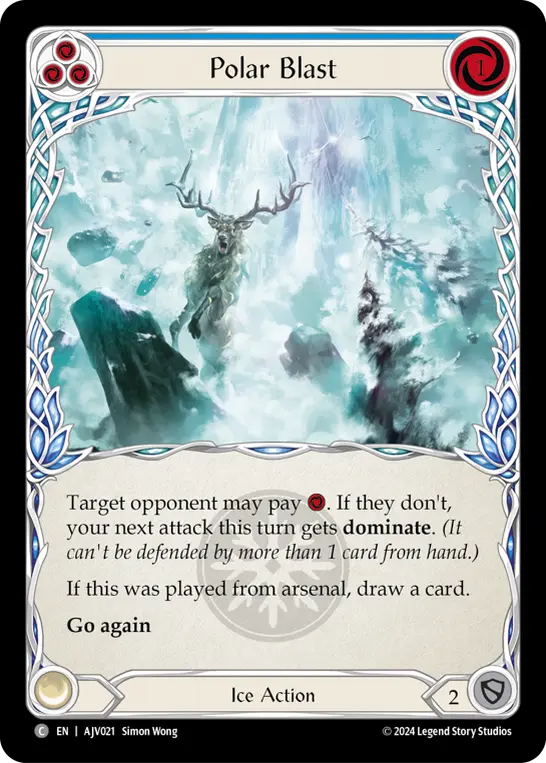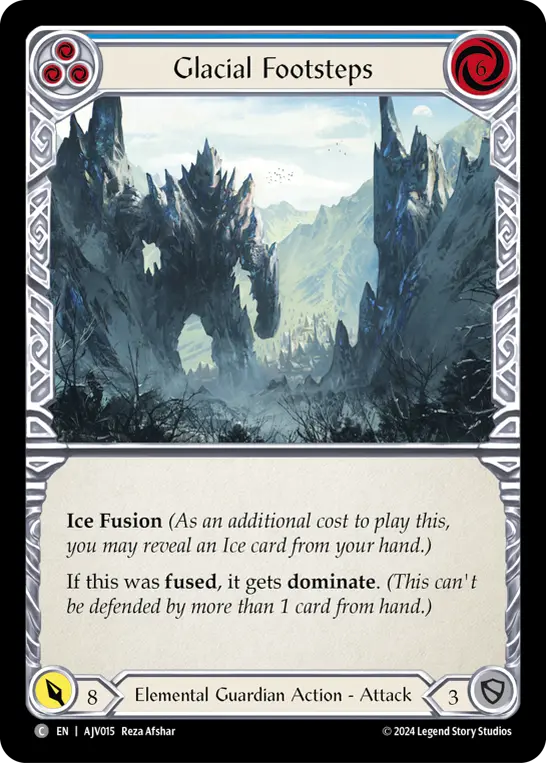Rangers and Guardians have always shared tactics. Bravo's ability to give Dominate was mirrored by Azalea; and while the threshold for triggering the effects are slightly different, both classes push disruption effects tied to successfully dealing damage.
So it came as no surprise when the shared element between Oldhim and Lexi was defined by precisely those elements. Ice, as a game mechanic, is disruptive and relentless. It's hard to block, but you really want to block it. All of it.
The Essence of Ice

To put it succinctly, Ice slows you down. The effects found on Ice cards may add to resource costs, force discards, or even end turns. Similar to the Traps of Crucible of War, many of these effects can be avoided by paying a resource cost- a form of disruption in and of itself.
This alternative to suffering the card's effect often ends up being the variable across a card cycle. As these alternative costs are being paid by the opponent during your turn, a 1-resource cost is often just as effective as a 3-resource cost: both represent a card from their hand.


Because Ice is so concerned with hitting, dominate is a prominent theme of the card pool. All of Ice's dominate effects are tied to a condition: Weave Ice requires a successful fusion, while Polar Blast offers a way out for the opponent, should they prefer to pay resources. As is common in dominate strategies, Ice also has leading buffs; Weave Ice is joined by Ice Quake in this category.

Flesh and Blood has largely avoided penalizing opponents with direct discards from hand, but Ice is allowed to dabble in this tactic- expanding on similar effects found in the Guardian and Ranger card pools. Ice cards always present this form of disruption paired with the option to pitch instead; as such, they are in effect removing a card from hand, but giving the opponent the option of where the card goes after that.


A common theme found across Ice, Lightning, and Earth cards is additional functionality from the arsenal. That's because the fusion mechanic sees you ending turns with that Ice card still in hand. Having said that, Ice sees the least benefit from finding its way into arsenal; both Guardian and Ranger benefit extensively from arsenal use already, and needed little incentive to utilize it!
Ice and the Guardian: Cold, Hard, Eternal

Frozen water can take on many forms, and that's well represented in the diversity between Oldhim's use of the element and Lexi's. When it comes to the Elemental Guardian, Ice is about strength and stasis.


When an Ice Guardian gains dominate, the net result is largely damage. Guardians do have hit effects- most notably, the crush effects of the standard Guardian card pool- but the primary threat of a dominated attack from a Guardian is that it doesn't take many of those to kill you.
Adding Ice to Oldhim's toolbox gives him much greater access to dominate than he's typically allowed. He can focus his energy on blocking and fatiguing his opponent, knowing that it only takes a couple attacks to win.


With the inevitability of both dominated attacks and eventual fatigue, Ice Guardian turns its attention to slowing the tempo of the game. Cards like Emerging Avalanche and Snow Under continue Ice's theme of Frostbite. Then there's Oldhim's ability, and Biting Gale that strip cards from the enemy's hand mid-attack!


Ice and the Ranger: Light, Sticky, Disruptive

If Guardian is a glacier, Ranger is a snowstorm. The Ice Ranger is a snowballing flurry, coating the enemy in effects that ruin their plans.

Dominate comes easily to Lexi, a built-in aspect of her most basic weapon. But she has to work to turn that dominate into significant damage. The entire Ranger attack suite is capped at 5 damage, meaning only the strongest attacks even climb over the prototypical 'defense reaction for 4'.


To combat this, Elemental Ranger has arrows that riff on the theme of Frostbite by taxing the enemy's defensive plays. Cold Wave and Frost Lock both add to the cost of cards played during your turn- namely, defense reactions, instants, and those pesky Wizard actions-turned-instant.


As you would expect, Lexi deals in conventional Frostbite as well. Ice cards that end up in arsenal at the end of your last turn become Frostbite tokens this turn, before you play them out to make room for your next arrow.

Perhaps the most definitive example of what Ice Rangers are all about is Chilling Icevein. Coming off the back of your typical turn- one in which you fused an arrow and ended the turn by putting that Ice card into arsenal- Lexi can reveal that card to stick the enemy with Frostbite, then load Icevein with Shiver (giving it dominate), fire it with a fusion, and slide in some damage while drastically decreasing their options for the next turn. You've now disrupted their costs, disrupted their hand, and progressed toward your goal of dropping their life total to zero.
Shattering Ice
If you find yourself facing down one of these winter warriors, it's useful to know where the cracks lie.
Fusion is a fickle mechanic. It requires a certain inefficiency in hand use- you must be holding an extra card, and specifically an Ice card, after playing your attack and pitching for its costs. And unlike Earth (which cycles itself pretty effectively) and Lightning (which often plays at Instant speed, or can be played out after the fused attack's go again), Ice cards tend to get stuck either in your hand or in your arsenal, slowing down your draw.

The easiest Ice cards to utilize are action cards with disruption effects; notably, these aren't dealing damage, they're just impairing the opponent's ability to deal damage back. Unless the Ice player has drawn into multiple Ice cards, they're not going to play these actions without first showing them to you- and probably even sticking them in arsenal. Use that information to plan for how you'll deal with those disruptions!
When you find yourself with the opportunity to apply pressure, by all means do so! Guardians rely heavily on resources, but so do Rangers, in that they're usually build with a heavy focus on red cards (to maximize their damage output) and rely on efficient pitching to get by. Any card you pull from their hands represents a compromise on their optimal counter-attack; no block is played without sacrifice.

But the best strategic counter to the role of Ice in the meta comes before you shuffle up your deck. Build with Frostbite in mind and adjust your resource curve to accommodate some extra costs. Assume you may need to pay a little more, and that you won't have the option to use two cards to pay for that key attack. That means sacrificing some damage stats in favor of a better pitch color.
Ice may feel oppressive in the early days of Tales of Aria, where unrefined and greedy decks are ill-equipped for disruptive, controlling opponents. But with a few changes to your deck's strategy and structure, you can find a path forward through the blinding snow.




